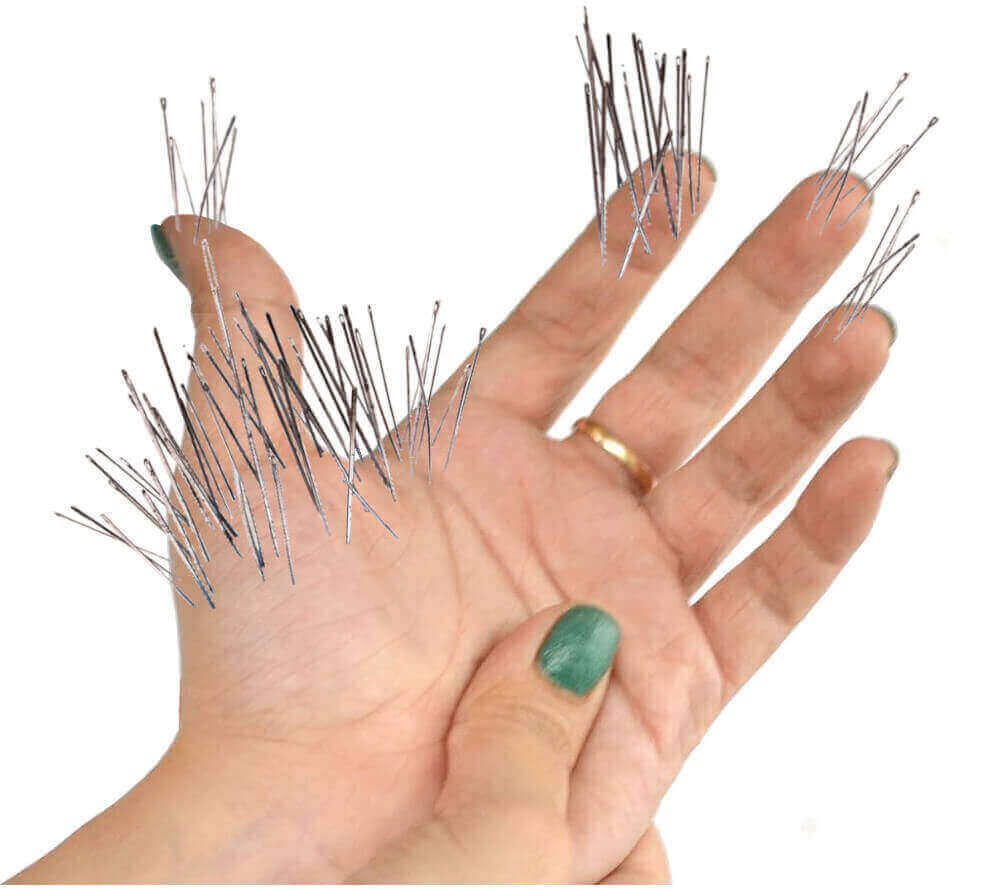What Carpal Tunnel Pain is Like
By Dr. M. Zannakis | The CarpalRx
Carpal tunnel pain is caused by compression of the
median nerve in your wrist, leading to tingling, numbness, burning or weakness in the thumb, index, middle, and part of the ring finger. Symptoms often worsen at night or with repetitive hand use. Early treatment with splints, nerve gliding, and activity modifications can prevent nerve damage and restore comfort.
Table of Contents
- Overview
- What causes carpal tunnel pain?
- How does the pain start?
- Mild carpal tunnel pain
- Moderate carpal tunnel pain
- Severe carpal tunnel pain
- End-stage carpal tunnel syndrome
- Treat carpal tunnel pain as soon as possible
- Summary
- FAQs
- About
Overview
Every person describes carpal tunnel pain differently. That's because "pain" means something different to different people.
Whichever way we describe it, hand or finger pain is a well-known
symptom of carpal tunnel syndrome. And so is
numbness, tingling,
weakness,
burning, and
shooting electric shocks - which usually accompany the pain. In fact, these symptoms are the most common when it comes to carpal tunnel syndrome.
What causes carpal tunnel pain?
Today, we know a great deal about carpal tunnel syndrome (sometimes just called "carpal tunnel"). And we know a lot about what causes the various symptoms it produces.
Pain, numbness, tingling and other abnormal sensations are the result of nerve damage. At it's core, a damaged nerve inside the wrist joint causes all of these symptoms.
Carpal tunnel syndrome is a painful and progressive nerve disorder. Doctors technically call it a
compressive neuropathy. That means the
median nerve (inside your wrist joint) is damaged.
The damage occurs because nearby tissues (usually tendons) inside the wrist joint inflame and push on the median nerve. The cause of the inflammation can vary, but the result is same. That is, the tissues swell and eventually compress (and crush) the median nerve.
It's thought that one reason tendons swell might be due to
repetitive and forceful use of your hands and fingers. That's why, for instance, typists,
hair stylists, carpenters,
transcriptionists, auto mechanics,
guitar players, and assembly line workers (just to name a few jobs) are infamous for getting carpal tunnel syndrome. Actually, anybody with an
occupation that requires specific
harmful hand activities is at high risk.
How does the pain start?
For most people, carpal tunnel syndrome begins almost without notice.
Maybe you feel some tingling at your fingertips when typing. Or if you tap your hand or wrist it tingles or causes a bit of pain in the fingers.
But as it advances, carpal tunnel syndrome becomes more and more unpleasant. Numbness and tingling usually get more intense. And if pain was only slight before,
it gets much worse in a matter of weeks. That’s when life becomes truly miserable.
The rest of this article describes the 4 stages of carpal tunnel syndrome. Briefly, they are:
- Mild: This is when symptoms become noticeable. They are worse when you're relaxing or sleeping. Carpal tunnel pain or numbness keep you up at night. During the day, you may notice dropping things a lot. Your hands feel clumsy.
- Moderate:
Symptoms start to bother you during the daytime. They're more intense, and other symptoms also may appear. You might feel shooting or radiating carpal tunnel pain. Tingling and numbness intensify. You lose more hand strength and dexterity.
- Severe: This is when symptoms are maximally intense. They are so bad they interfere with every aspect of your life. Pain, numbness, and tingling are almost unbearable. Hand weakness and dexterity loss is accompanied by loss of sensitivity to hot or cold.
- End-stage: In this stage, much of your median nerve has died. It results in catastrophic loss loss of hand function. But carpal tunnel pain decreases (due to the dead nerve). Numbness or tingling usually remain.
The 4 stages are a general outline of carpal tunnel's advancement, and they can vary from person to person. That means the symptoms, their intensity, and duration may be differ. For example, some people advance to the severe stage in just a few months. But others might take several years. Which ever way it advances, this neurological condition is progressive and usually worsens without intervention.
Mild carpal tunnel pain
In the
mild
stage of carpal tunnel, pain, numbness or tingling definitely begin to make a showing. These sensations are usually more pronounced in the thumb, index and middle fingers. However, the little finger doesn’t show signs whatsoever.
Pain is often accompanied by your fingers feeling puffy, even though they’re not. In over 80% of patients, these sensations occur in both hands within a 6 month period (called
bilateral carpal tunnel syndrome).
The carpal tunnel pain will usually have one or more of the following qualities during the mild stage:
- Burning or itching
- Deep, dull, aching or throbbing
- Sharp, stinging or stabbing
- Shooting or electrical
In this
mild
stage, the finger or hand pain usually is intermittent. It's rarer for pain to be constant in the mild stage. The level of carpal tunnel pain
usually is described as "annoying". It's rarer to describe the pain as "intense" during this stage.
Another characteristic of
mild stage carpal tunnel pain or numbness is it usually happens while you try to sleep at night. In fact, one of the hallmark symptoms of
mild carpal tunnel syndrome is that you have to wake up to "rub out" the pain or "shake out" the numbness.
Many patients first notice pain or numbness when
driving their car. Holding the steering wheel causes pain, numbness or tingling in the palm or fingertips. Likewise, holding a phone up to your ear causes similar symptoms to appear.
As mild symptoms progress, patients begin to notice dexterity problems. Hands feel clumsy grasping a drinking glass, grooming, tying a shoelace, buttoning a shirt or picking up coins or keys. They begin to drop things.
Carpal tunnel syndrome weakens your hand. In the
mild
stage you first begin to notice a loss of
grip strength but it's not a huge problem yet. As the condition worsens (without treatment), loss of hand strength will be one of your biggest problems.
Moderate carpal tunnel pain
Most often, pain advances from barely noticeable to intense within 6 months. This is when it reaches the
moderate
stage. In fact, if left untreated, the mild stage will almost always advance to the
moderate stage of carpal tunnel. Pain (or numbness) will be noticeably more intense. The painful or numbing feelings will be present most of the day, not just while trying to sleep. You even have pain when your hand is resting during the daytime.
Usually at this point most people realize they have a big problem. Many begin to wear a
wrist brace at night. Unfortunately, most people use the wrong type of carpal tunnel brace. And it ends up doing more harm than good.
During the
moderate stage of carpal tunnel, pain may spread to all of the fingers (but not the pinky finger). It may also spread into the palm of the hand. Sometimes pain radiates to the wrist and forearm. This pain usually starts off intermittently, and then becomes constant.
In the
moderate stage, as carpal tunnel pain becomes more constant, other problems also worsen. If grip strength and/or dexterity were a problem before, then it's very significant now. The hand feels clumsy or awkward almost all the time. That results in constantly
dropping dishes or cups. Sometimes the loss of tactile feelings and strength cause your phone to flop out of your hand. Writing with a pen is very difficult.
Severe carpal tunnel pain
Doctors characterize the
severe stage of carpal tunnel syndrome when a patient's quality of life has significantly deteriorated. Basically, their carpal tunnel pain or numbness affects every aspect
of their waking and sleeping hours. There simply is no getting away from the relentless discomfort.
In the
severe stage of carpal tunnel,
pain is very intense. Descriptions of the pain are often said to be crushing, punishing, fearful or brutal. Many patients say their hand feels like it's being crushed in a vice. And a majority of patients tell doctors:
"I feel like I want to cut my hand off."
In the
severe stage of carpal tunnel, other symptoms also intensify and become relentless. For instance, many patients lose the ability to sense hot or cold on their skin. That means there's no detecting boiling at your fingertips. Obviously, this is potentially hazardous. And it's the reason many
severe stage carpal tunnel patients scald themselves in the kitchen. In fact, patients have said they noticed their fingertips burning on a stove only when they smelled it.
Hand and finger dexterity is almost completely lost in the
severe
stage. The excruciating pain makes just about any movement a major ordeal. Just toileting or grooming is nearly impossible without it driving you mad.
Severe stage patients find they have to force themselves to perform simple activities. And even then, the process is difficult at best. At this point, it's common for patients call upon someone else to prepare food, turn door knobs, make a bed or tend to small children.
End-stage carpal tunnel syndrome
The final stage of carpal tunnel syndrome is called the
end-stage. Usually, its most noticeable feature
is
atrophy,
or wasting in the muscles at the base of the thumb.
That means the normally thick and plump muscle elevation (thenar eminence) at your thumb's base is now flat or wrinkly. There may still be some thumb function and feeling left over. But thumb strength and movement is drastically compromised. Most patients at this stage cannot touch their thumb to their pinky.
Ironically in the
end-stage of carpal tunnel, pain will usually diminish.
But that's not a positive outcome. It means the nerve fibers to your hand and fingers have
essentially died.
There is no restoring feeling or function whatsoever at this point.
Most people take 6-12 months to reach the end-stage. Others might take several years. This time frame is completely unpredictable.
Treat carpal tunnel pain as soon as possible
On the whole, carpal tunnel syndrome is progressive. It severely deteriorates hand and finger function. The pain, numbness, tingling, and weakness progress until, ultimately, nerve fibers die out and you feel nothing.
The unrelenting and catastrophic devastation of the hand demonstrates why you
must treat any sign of carpal tunnel pain or numbness seriously - and immediately.
In fact, patients who begin treatment from the first sign of symptoms (and even up to the moderate stage) have a
much better chance of completely eliminating symptoms. Again, the key is early treatment.
Surgery doesn't always result in good outcomes. In fact, about
50% of surgery patients are dissatisfied with their results at 2 years. In contrast, appropriate
non-surgical treatments can eliminate symptoms and restore hand function in virtually every patient. Patients who treat carpal tunnel early and maintain their treatment regimen usually will see all symptoms go into remission.
Summary
Carpal tunnel pain, numbness, and other symptoms creep up on you slowly. By the time you notice them and try to do something about it, they usually have already progressed to the moderate stage. Without treatment, symptoms will only intensify. But the earlier you treat, the better your chances of eliminating symptoms and restoring your hand.
FAQs
- How can I tell which level of carpal tunnel severity I have?
You can see your doctor for a full diagnosis of carpal tunnel syndrome. You can also use this
Quiz, which is designed to assess your carpal tunnel's severity level.
- Can carpal tunnel pain go away by itself?
Yes, carpal tunnel pain can spontaneously resolve, even without any intervention. However, the chances of recurrence are much greater if you don't treat the initial pain.
- Does carpal tunnel syndrome always advance to the severe stage?
No, carpal tunnel syndrome can plateau at any stage. And it can remain there for years, with on-again and off-again pain and other symptoms. However, ignoring it is a gamble. It can worsen, which makes treating it more difficult.
About








